Hairy Cell Leukemia (HCL)
You are here
Definition
Hairy cell leukemia is a mature B cell neoplasm. It is usually classified as a sub-type of chronic lymphoid leukemia (CLL) for convenience. It is uncommon, representing about 2% of all leukemias, or less than a total of 2000 new cases diagnosed each year in North America and Western Europe combined.
Sample Cases
Click here for instructions on how to download the free FCS Express Reader to view and manipulate the sample cases.
| Case Name (click on case name to open) |
Comments | Size |
| HCL1 | Hairy Cell | 3.76 MB |
| case 12 | Classic HCL This case was kindly provided by the ASCP Press. It is part of Flow Cytometry in Clinical Diagnosis by John Carey, Phil McCoy and David Keren. |
741 kB |
| case 13 | HCL This case was kindly provided by the ASCP Press. It is part of Flow Cytometry in Clinical Diagnosis by John Carey, Phil McCoy and David Keren. |
1027 kB |
| case 14 | CD5+ HCL This case was kindly provided by the ASCP Press. It is part of Flow Cytometry in Clinical Diagnosis by John Carey, Phil McCoy and David Keren. |
861 kB |
Epidemiology
This disease is rare, with fewer than 1 in 10,000 people being diagnosed with HCL during their lives. Although most patients are white males over the age of 50, it has been diagnosed in at least one teenager . Men are four to five times more likely to develop hairy cell leukemia than women. It does not appear to be hereditary, although occasional familial cases have been reported, usually showing a common HLA type.
Possible causes
The cause is unknown, but, in general, believed not to be caused by tobacco, ionizing radiation, pesticides, or industrial chemicals other than possibly diesel. Farming and gardening appear to increase the risk in some studies. The possibility that HCL is caused by a random accident during routine cell division cannot be ruled out.
Morphology
Abnormal white blood cells bearing hair-like projections from the cytoplasm are seen on blood film examination or bone marrow biopsy. These are medium sized cells with pale cytoplasm, oval and often reniform or bean-shaped nuclei and clumped or evenly distributed chromatin.
| Example of HCL cells | Example of HCL cells |
Immunophenotyping
Hairy cells are larger than normal and positive for CD19, CD20, CD22, CD11c, CD25, CD103, and FMC7. Hairy cell leukemia-variant (HCL-V), which shares some characteristics with B cell prolymphocytic leukemia (B-PLL), does not show CD25 (also called the Interleukin-2 receptor, alpha). Because a patient could have more than one similar disease, it is also necessary to rule out the presence of leukemias and lymphomas such as SMZL or B-PLL.
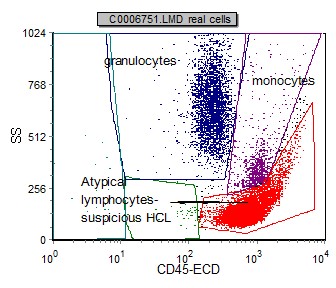 |
| Note the red lymphocyte population and the variation in size (higher SSC) requiring further investigation. |
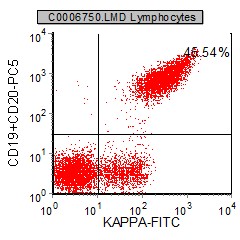 |
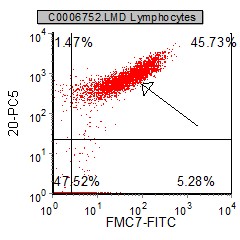 |
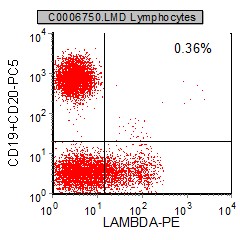 |
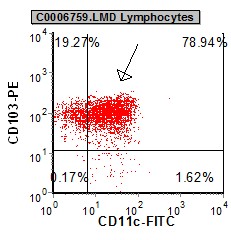 |
| The majority of the lymphocytes (red)express a moderate-bright monoclonal kappa light chain expansion. | The lymphocyte brightly express CD20 and FMC-7. CD11c and CD103 are characteristic of HCL. |
Other relevant tests
Cytochemistry: Tartrate resistant acid phosphatase is positive in HCL.
Genetics: While there are few genomic imbalances in the hairy cells, the expression of genes is dysregulated in a complex and specific pattern. The cells underexpress 3p24, 3p21, 3q13.3-q22, 4p16, 11q23, 14q22-q24, 15q21-q22, 15q24-q25, and 17q22-q24 and overexpress 13q31 and Xq13.3-q21.
Flow Diagnosis
FC shows increased SSC placing the leukemic cells in the 'monocytic' region of the CD45 vs SSC plot. These cells are bright CD20, CD11c and surface immunoglobulins (kappa or lambda). CD25, CD11c and CD103 are coexpressed on these cells. CD25 can be negative in a subset of HCL variants (HCLv). Occassionally, an aberrant phenotype is expressed.
Example case to download using FCS Express reader
References
1. http://bloodjournal.hematologylibrary.org/cgi/content/abstract/76/1/157
2. http://bloodjournal.hematologylibrary.org/cgi/content/abstract/82/2/528
Links
1. A patient blogs about his battle with HCL - http://hcljournal.blogspot.com/
